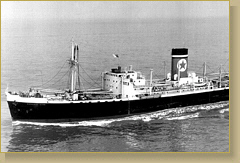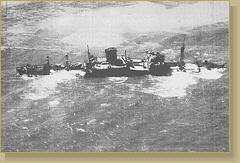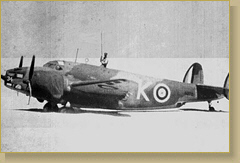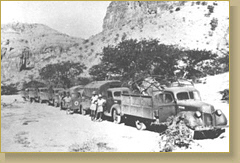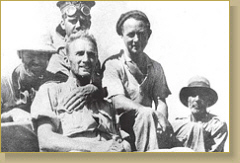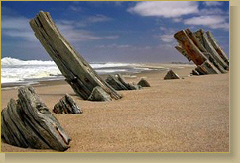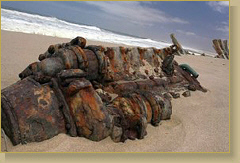|
History of the Dunedin Star . . .
On the night of 29
November 1942, a passenger ship. the Dunedin
Star was on its way from Liverpool to Cape Town with
107 people onboard of whom 21 passengers and a very
important cargo of weapons and ammunition.
But then with the
Namibian Coast about 16 kilometers on the starboard
side, the ship suddenly shudder as if shaken by some
giant hand, a part of her keel was ripped open with
water streaming into her engine room. The crew
immediately start pumping water out with 5
electrical pumps, but soon the water started seeping
through the watertight door hinges between the
engine room and the propeller shaft housing.
The only
obstruction according to the Marine Charts, was the
Clan Alphine sandbank situated between 5 - 8.5km
from the coast, although it was mark "PD" (position
doubtful) therefore the captain suspected that they
were in fact hit by a torpedo as it was known that
submarines was operating in the area.
Half past 10 that
evening the radio station at Walvis Bay received the
Dunedin Star emergency calls with the exact position
where they hit the sandbank and according to the
Captains calculations they would sink in 3 - 4 hours
and he therefore decided to proceed directly to the
coast and try and beach the ship, under his
guidance and experience the ship was steered towards
the beach without more damaged to where it
eventually got stuck on a sandbank, in the meantime
they were advised by military intelligences at
Walvis Bay that 2 ships, currently on Anker in
Walvis Bay, will be dispatched and should reached
them by the 2 December 1942. The two ships,
the minesweeper Nerine and tugboat Sir Charles
Elliot took food and water aboard and where on their
way. Military Intelligence also contacted the
South African Navy in Cape Town and within minutes
they have located and contacted two ships in the
vicinity of the Dunedin Star, the British freight
ship "Manchester" and a Norwegian Motor
ship "Temeraine" and ask to assist the Dunedin
Star.
In the meantime the
captain of the Dunedin Star become more worried that
the Dunedin Star would break up and decided that
everyone should leave the ship and a day after the
ship got stuck on the sandbank, the first people
where taken to the beach by motorboat, the rough
seas and high waves made it a very risky operation
and after the third run the motorboat broke
down, but 63 people among whom woman and children
was safe on the mainland. The captain and 43
men was still on the Dunedin Star. On the
evening of the 31st November the Temeraine arrived
at the scene, shortly followed by the Manchester.
The next day the crew of the two ships brought all
the remaining 43 men and Captain aboard from the
Dunedin Star. Due to bad seas and weather they
could not make it near the beach food and water for
the people on land. Fortunately, the Captain
radioed Walvis Bay and asked that an aircraft been
dispatched to drop food, water, blankets etc for the
people on the land. By now they become worried as
they had not much water and food left.
Nights was
extremely cold and they had to sleep on the sand,
with no blankets or any other protection against the
elements, and during the day they were exposed to
the desert heat, sun and wind. From the
Manchester they signalled them that an aircraft with
food, tents, blankets and water are on its way from
Walvis Bay and that convoy of vehicles has been
dispatched from Windhoek to come and pick them up.
On the 2nd
December, the Nerine and Towboat Sir Charles Elliot
reached the Dunedin Star. The Temeraine that
remained on the scene, then departed for Walvis Bay
with all the crew and passengers that they picked up
from the Dunedin Star, followed by the towboat Sir
Charles Elliot after they managed to unload her
cargo on land.
A brand new
Lockheed Ventura of the South Africa Air force
depart Cape Town on the 3rd December and flew to
Walvis Bay where it took in containers with water
and food. The pilot Immins Naudé and his
crew of 3 departed the same day for the Skeleton
Coast, and noticed another ship stranded near Rocky
Point, on closer investigation they saw much to
their astonishment that it was the towboat Sir
Charles Elliot who was on her way back to Walvis
Bay. They radioed the position to Walvis Bay
and proceed to the location to the Dunedin Star.
Arriving at the the Dunedin Star the commenced by
dropping all the proviand, containers, food etc.
The crew however feel that it is their moral duty to
at least pick up the woman and children, so the
pilot landed but the aircraft subsequently got stuck
in the soft sand, and nothing could get it out of
there. The aircraft also become another victim
of the Skeleton Coast.
In the meantime at
the scene of the towboat Sir Charles Elliot, things
has deteriated to such and extend that the ship has
started to break up and the crew attempted several
times to get to the beach, during which 2 people
drowned but the remaining crew and passengers
eventually made it to the beach, putting them in the
same situation as the 63 people on the land at the
Dunedin Star.
Further north the
Manchester and the Nerine was still trying to send
food and water to the stranded people at the Dunedin
Star, but the heavy seas and strong currents swept
the rafts away and eventually with no more cargo
they both set course for Walvis Bay.
On the 4th of
December the minesweeper Natalia set course for the
Dunedin Star loaded with much needed food, water and
medicine. Her radio capacity however was of a
very short reach and to overcome this, they
took pigeons along. They successfully
used the pigeons to get important information to
Walvis Bay. The pigeons which was sent off in pairs,
more than half reached Walvis Bay again and the
information they brought back was of utmost
importance to the rescue operations and planning at
Walvis Bay. The heavy seas and weather
has in the meantime subsided a bit, and the cargo
brought by the Natalia could all be successfully
unloaded to the beach.
On 5 and 6 December
another 3 Ventura bombers were dispatched from
Pretoria and Cape Town with blankets, food, water
medicine and tents onboard. One of the pilots
have executed a successful landing and take off at
Rocky Point and he agreed to try it again.
After dropping the cargo at the Dunedin Star, he and
another Ventura, landed successfully near the
towboat Sir Charles Elliot and picked up the crew.
The Vehicle convoy
was also spotted by the Ventura pilot about 20km
away and on 12 December they reached the
remaining people. All the 63 People was then
loaded on the trucks and they started the slow and
cumbersome journey back to Windhoek, rivers in flood
made it a difficult task and by the time the have reached Kamanjab, they have lost 3 vehicles. But they
persist and on Christmas Day 1942 they reached
Windhoek from where they were flown to Cape Town. |
